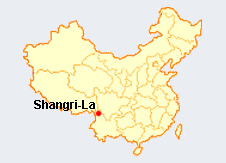Win a coupon
Your opinion is vital for us to improve our service and further to offer you an excellent China trip. Now, your golden ideas are needed and they may earn you a coupon. Join us for your chance to win a prize!
With your green fingers make an easy but visible difference to the environment along your trip way
Home > China Guide > Shangri-La
Shangri-La, also known as Zhongdian to Chinese and Gyalthang to the Tibetans, is a small Tibetan town on the road between Lijiang and Tibet.

Shangri-La Tourist Attractions
Shangri-La Old Town Songzanlin Monastery Pudacuo National Park




Shangri-La, known as Zhongdian to Chinese and Gyalthang to the Tibetans, is a small Tibetan town on the road between Lijiang and Tibet. As the capital of Diqing Tibetan Autonomous Prefecture, it is the largest self-governing Tibetan area outside of the Tibet Province. On this highland town (elve. 3,380 meters) live the dominant Tibetan residents and other over 10 ethnic minorities.
Shangri-La is home to vast rivers-and-streams-dotted meadow, traditional Tibetan farmsteads, snow-capped mountains, remote temples, scattered villages and the start of the Tibetan world. The idyllic mountain scenery is the sources of Joseph Rock's articles in National Geography Magazine which also is said to have inspired the depiction of the serene unearthly paradise in Lost Horizon of James Hilton.
The local government, following Lijiang and Dali tourism booming steps, has made an effort to replace the banned logging industry with tourism by promoting it as the legendary Shangri-La for its many similarities to Hilton's description. This promotion has successfully stirred many searching souls for the multi-nationality cultures and unique natural allure, turning this original one-yak town into a tourist destination.
The main attractions in Shangri-La are scattered around like Tibetan-touch old town, the old Tibetan monastery complex--Ganden Sumtseling Gompa, the seasonal Napa Lake (with rare species in Sep-Mar), Pudacuo National Park, Meili Mountain Range, etc. The remote spots are difficult to cover independently for the lack of transport.
Early summer (May-Jul) and early autumn (Sep-Oct) are the best visit time with the lusher and more flowering scenery. During the winter the city and the transportation tend to be partially shut down for the snow storms. Mid to late June Shangri-La holds a horse-racing festival when singing, eating, dancing and horse riding last for days. The lunar 15th of Jan. will see the Tibetan Buddhism assembly event in the Ganden Sumtseling Gompa.
Couples of days stay in Shangri-La are suggested for the acclimatization since altitude sickness is a real issue here.
- Air quality: ★★★★★
- Foreigner-friendly degree: ★★★★★
- Public security degree: ★★★☆☆
- Hygienic degree: ★★☆☆☆
- Traffic jam degree: ☆☆☆☆☆
- Internationalization level: ★☆☆☆☆
- Consumption level: ★★★☆☆
- Language: Tibetan, Southwestern Mandarin
- Best traveling season: May-Jul, Sep-Oct
- Tourist resources: nature, tibetan culture, historic relics
- Airport to downtown: 5 km
- Demographics: Tibetan (33.8%), Naxi, Lisu, Han
- Key words: snow mountain, grassland, tibetan, monastery
- 云南省旅游投诉电话 Yunnan Tourism Complaints
- 0871-4608315
- 迪庆州旅游投诉电话 Diqing Tourism Complaints
- 0887-96927
Useful lines:

